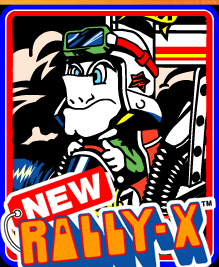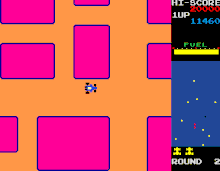New Rally-X
New Rally-X[lower-alpha 1] is a maze and driving arcade game that was released by Namco in 1981. It runs on similar hardware to that of its predecessor Rally-X, and as its name suggests, it is a revised version of that title, which was released in the previous year. The only differences are that it has slightly enhanced graphics, easier gameplay, a new soundtrack, and a "Lucky Flag" that gives the player extra points for remaining fuel when collected, after which the round will continue if there are still flags remaining. The mazes are mostly identical, with some of the blocks from Rally-X changed into roads to reduce dead ends, and some different flag and rock locations. This title was manufactured in greater numbers and was much more popular in Japan than its predecessor.
| New Rally-X | |
|---|---|
 | |
| Developer(s) | Namco |
| Publisher(s) | Namco |
| Designer(s) | Shigeru Yokoyama[1] Kouichi Tashiro[1] |
| Programmer(s) | Kazuo Kurosu[1] |
| Composer(s) | Nobuyuki Ohnogi[1] |
| Series | Rally-X |
| Platform(s) | Arcade, Mobile phone, Xbox 360 |
| Release |
|
| Genre(s) | Maze |
| Mode(s) | Single-player, multiplayer |
| Cabinet | Upright, tabletop |
| Arcade system | Rally-X |
While the original Rally-X (which was released under a Midway Games license) was a moderate hit in the United States, Midway only distributed this updated version in North America as an upgrade kit for Rally-X cabinets. The game appeared quite frequently in mainland Europe and the United Kingdom, mainly in the form of uncredited bootlegs. It was at least as popular as its predecessor in these parts of the world, if not even more so, primarily due to the title's greater playability and abundance of bootleg board stock.
Gameplay

The player controls a blue racing car and their goal is to collect all yellow flags (checkpoints) of the map before their fuel bar (which depletes itself slowly) runs out. Each round has ten flags, being those eight common and two special: a Lucky Checkpoint, that rewards the player with points according to their current fuel bar's level, and a Special Checkpoint, that doubles the score of the others flags. The antagonists of the game are similar-looking red cars that chase the player and make them to lose a life by colliding with them. The player can defend themself by pressing the smoke screen button, making the red cars unable to move for a short period if they run over the smoke screens. Another obstacles are big but immovable rocks, that also make the player lose a life by colliding with them. There are challenging rounds, in which the enemy cars only move themselves if the player runs out of fuel by taking too long to collect all flags.
Legacy
A version of New Rally-X is the load-up game in the PlayStation Portable game Ridge Racer. It was also included in Namco Museum Battle Collection for the PSP, along with an entirely new "Arrangement" version of it which has updated graphics, music, and new gameplay features. The game was also released on the Microsoft Xbox 360 Xbox Live Arcade service on December 27, 2006, and on the Wii Virtual Console in Japan on October 6, 2009. In addition, it has also been included in several editions of the Namco plug-n-play game series, from Jakks Pacific. A version known as New Rally-X S (the "S" stands for "Special") was also released on Facebook. In November 2010, it was included in Namco Museum Megamix for the Wii.
Notes
References
- Szczepaniak, John (11 August 2014). The Untold History of Japanese Game Developers (First ed.). p. 201. ISBN 978-0992926007. Retrieved 12 August 2019.